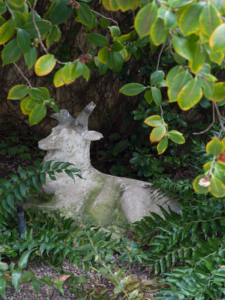Q: I love the idea of garden art, but can’t seem to commit to an actual piece. How can I chose the right one? –Judy, Austin TX
SB: Here’s the tricky thing: buying art for the garden is like buying any other art: you need to search it out. You can’t just go out and say “I’m going to buy a statue today”. You have to collect, you have to edit. You’ll know it when you see it. Now, once you’re out looking at pieces, you want to first of all make sure it’s in good condition, that it’s not falling apart. The best thing to do is always buy from a reputable dealer, a place where someone can talk to you about it. If there are just a thousand of these things standing there, it’s probably not very good. If you have more confidence in your own eye, you can find pieces anywhere from garage sales to art dealers.
 BACK TO CLASSICS
BACK TO CLASSICS
This cast iron putto designed by J.W. Fiske & Company circa 1890 is a classic form sited in a boxwood and hydrangea garden. What a perfect resting place for your eyes. When it comes to selecting, here’s what you’ve got to remember: Something well done is always the direction you want to go. And well done means you get a feeling for it. If it makes you feel good, then it’s a good piece. So if it’s a figure—whether it’s a lion or a dog or a human—you have to love the face. That doesn’t necessarily mean it’s expensive, you just need to pay attention and to love what you’re looking at.
 TWO MAIDENS
TWO MAIDENS
These circa 1900 English statues of maidens, partially clothed on original plinths, are made of refined cast stone. The knotted hair and draped robes are especially fine details suggesting that they were created with an early original mold. The color of the statue is set off beautiful by deep green ivy, and beautifully framed by the iron entry to the garden.
 ELEMENT OF SURPRISE
ELEMENT OF SURPRISE
The simplest of all, an unassuming 19th century French cast stone stag is barely noticed until seen from the vantage point of a nearby outdoor dining table. On the ground beneath an ancient camellia and nestled amongst holly fern, it sits on a gravel bed. The stag is lichen-covered with old residual white paint. Note that the antlers are broken but this only adds charm to the piece.
